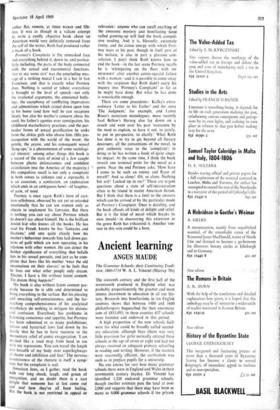Ancient learning
ANGUS MAUDE
The sixteenth century and the first half of the seventeenth produced in England what was probably proportionately the greatest and most intense investment in education in all our his- tory. Research into benefactions in ten English counties shows that between 1480 and 1660 philanthropists bequeathed the then enormous sum of £833,493; in these counties 437 schools were founded and endowed in this period.
A high proportion of the new schools built were for what could be broadly called second- ary education, although boys (there was very little provision for girls) normally entered these schools at the age of seven or eight and had not always received an adequate primary schooling in reading and writing. However, if the masters were reasonably efficient, the curriculum was such as to prepare pupils fpr a university.
No one knows for sure how many grammar -schools there were in England and Wales in-their seventeenth century heyday. Dr Vincent has identified 1,320 endowed grammar schools, though another estimate puts the total at over 2,000 and suggests that there may have been as many as 4000 grammar schools if the private fee-paying establishments are included.. Even quite small villages had their own schools. The great public schools of today were beginning even then to establish their primacy, and coun- try gentlemen and wealthy merchants were beginning to send their sons quite far afield as boarders. Oliver Cromwell sent four sons to Felsted and a ward to Eton.
The subsequent rapid decline of the grammar schools could not be attributed to government neglect. Even during , the interregnum, the government went to considerable lengths to conserve and encourage the endowed schools,
and after the Restoration this encouragement was continued in the interests of the established Church. It seems pretty clear that the decline
(and in many cases actual disappearance) of the
grammar schools, which proceeded apace dur- ing the eighteenth century and the first half of the nineteenth, was due to the increasing irrele- vance of the curriculum to current needs. This failure to meet the educational requirements of the time was in many cases intensified by the inadequacy of the teaching, especially where in- sufficient endowments led to parish priests doing the job in their spare time.
The curriculum in most of the endowed schools consisted almost entirely of Latin gram-
mar and religious instruction, with some Greek and occasionally Hebrew. Only very rarely were English or mathematics taught, let alone history or geography. Since the teaching was largely
by rote, while the discipline was often extremely savage, it is surprising that so many boys suc-
ceeded in achieving a classical education. Dr Vincent makes it clear that the success of a school depended almost entirely on the quality and attainments of the principal teacher, which is almost as true today as it was then.
Dr Vincent's book does not purport to be a continuous history. Based largely on the un- published survey of endowed grammar schools compiled by Christopher Wase in the 1670s, it is a composite picture of the state of ' these
schools in the second half of the seventeenth century. The treatment of the evidence is 'care- ful and meticulous, and the picture that emerges is of the greatest interest.
Fee-paying seems to have become common, but there was still a considerable provision for
the free secondary education of poor children, although often the original intentions of the founders could not be carried out owing to the failure of new benefactions to keep pace with the depreciation of the old endowments. Per- haps most fascinating of all is the history of rise, decline, fall and rebirth shown by some early grammar schools. Abingdon School, now a flourishing direct-grant grammar school, was a ninth century monastic foundation, abolished at the Dissolution and refounded as an endowed school in 1563. In 1766 it had 103 boys, includ- ing forty boarders, but between 1792 and 1809 the number of scholars on the foundation never exceeded two."Today it has nearly 600. At the beginning of the nineteenth century the ancient grammar school at Banbury had vanished with- out trace, 'and all record of its endowment had disappeared.' Its flourishing modem successor has recently been merged, in .a so-called compre- hensive school.
How many of the surviving ancient founda- tions will be left as grammar schools in ten years' time? Perhaps history can give us some com- fort. Schools that survived the eighteenth cen- tury parsons and went on to greatness can prob- ably survive Mr Edward Short—or at least rise again phoenix-like after he has done his worst with them.











































 Previous page
Previous page